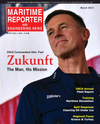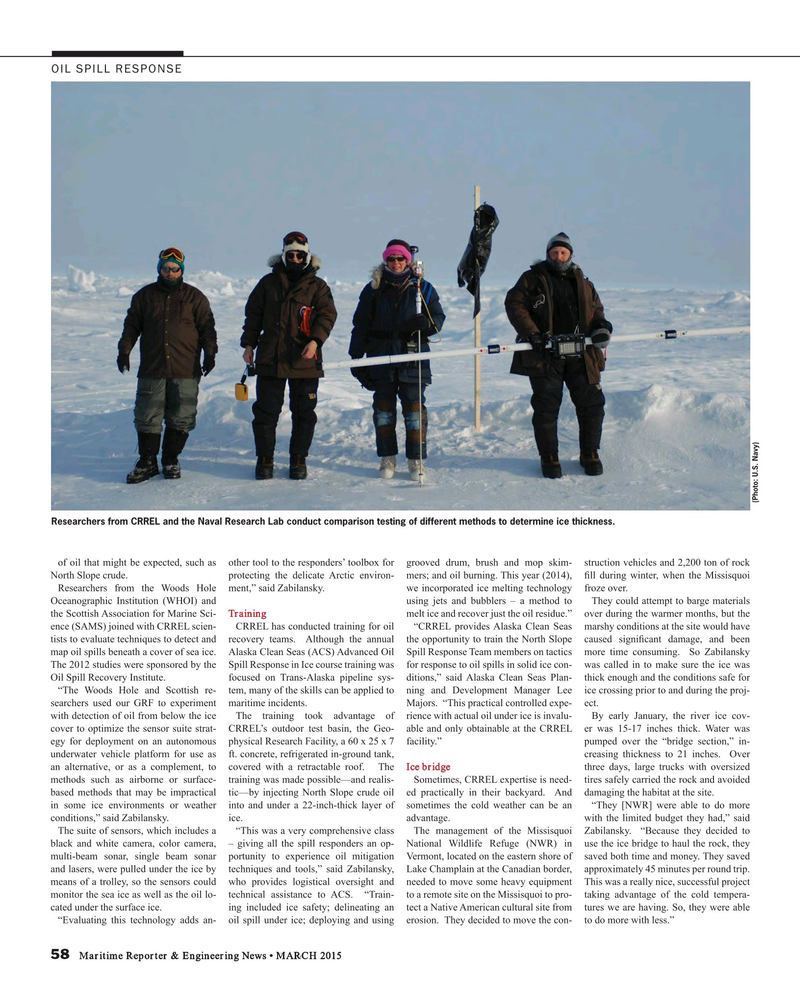
Page 58: of Maritime Reporter Magazine (March 2015)
U.S. Coast Guard Annual
Read this page in Pdf, Flash or Html5 edition of March 2015 Maritime Reporter Magazine
OIL SPILL RESPONSE (Photo: U.S. Navy)
Researchers from CRREL and the Naval Research Lab conduct comparison testing of different methods to determine ice thickness. of oil that might be expected, such as other tool to the responders’ toolbox for grooved drum, brush and mop skim- struction vehicles and 2,200 ton of rock
North Slope crude. protecting the delicate Arctic environ- mers; and oil burning. This year (2014), ? ll during winter, when the Missisquoi
Researchers from the Woods Hole ment,” said Zabilansky. we incorporated ice melting technology froze over.
Oceanographic Institution (WHOI) and using jets and bubblers – a method to They could attempt to barge materials the Scottish Association for Marine Sci- Training melt ice and recover just the oil residue.” over during the warmer months, but the ence (SAMS) joined with CRREL scien- CRREL has conducted training for oil “CRREL provides Alaska Clean Seas marshy conditions at the site would have tists to evaluate techniques to detect and recovery teams. Although the annual the opportunity to train the North Slope caused signi? cant damage, and been map oil spills beneath a cover of sea ice. Alaska Clean Seas (ACS) Advanced Oil Spill Response Team members on tactics more time consuming. So Zabilansky
The 2012 studies were sponsored by the Spill Response in Ice course training was for response to oil spills in solid ice con- was called in to make sure the ice was
Oil Spill Recovery Institute. focused on Trans-Alaska pipeline sys- ditions,” said Alaska Clean Seas Plan- thick enough and the conditions safe for “The Woods Hole and Scottish re- tem, many of the skills can be applied to ning and Development Manager Lee ice crossing prior to and during the proj- searchers used our GRF to experiment maritime incidents. Majors. “This practical controlled expe- ect. with detection of oil from below the ice The training took advantage of rience with actual oil under ice is invalu- By early January, the river ice cov- cover to optimize the sensor suite strat- CRREL’s outdoor test basin, the Geo- able and only obtainable at the CRREL er was 15-17 inches thick. Water was egy for deployment on an autonomous physical Research Facility, a 60 x 25 x 7 facility.” pumped over the “bridge section,” in- underwater vehicle platform for use as ft. concrete, refrigerated in-ground tank, creasing thickness to 21 inches. Over an alternative, or as a complement, to covered with a retractable roof. The Ice bridge three days, large trucks with oversized methods such as airborne or surface- training was made possible—and realis- Sometimes, CRREL expertise is need- tires safely carried the rock and avoided based methods that may be impractical tic—by injecting North Slope crude oil ed practically in their backyard. And damaging the habitat at the site. in some ice environments or weather into and under a 22-inch-thick layer of sometimes the cold weather can be an “They [NWR] were able to do more conditions,” said Zabilansky. ice. advantage. with the limited budget they had,” said
The suite of sensors, which includes a “This was a very comprehensive class The management of the Missisquoi Zabilansky. “Because they decided to black and white camera, color camera, – giving all the spill responders an op- National Wildlife Refuge (NWR) in use the ice bridge to haul the rock, they multi-beam sonar, single beam sonar portunity to experience oil mitigation Vermont, located on the eastern shore of saved both time and money. They saved and lasers, were pulled under the ice by techniques and tools,” said Zabilansky, Lake Champlain at the Canadian border, approximately 45 minutes per round trip. means of a trolley, so the sensors could who provides logistical oversight and needed to move some heavy equipment This was a really nice, successful project monitor the sea ice as well as the oil lo- technical assistance to ACS. “Train- to a remote site on the Missisquoi to pro- taking advantage of the cold tempera- cated under the surface ice. ing included ice safety; delineating an tect a Native American cultural site from tures we are having. So, they were able “Evaluating this technology adds an- oil spill under ice; deploying and using erosion. They decided to move the con- to do more with less.” 58 Maritime Reporter & Engineering News • MARCH 2015
MR #3 (58-65).indd 58 MR #3 (58-65).indd 58 3/3/2015 11:41:29 AM3/3/2015 11:41:29 AM

 57
57

 59
59
